|
|
|
 |
|
"THE VISION OF ISAIAH,
THE SON OF AMOZ,
WHICH HE SAW CONCERNING JUDAH AND JERUSALEM,
IN THE DAYS OF UZZIAH, JOTHAM, AHAZ AND HEZEKIAH, KINGS OF JUDAH"
ISAIAH 1:1
|
|
|
 |
|
 |
|
|
It was a stray goat
which led to what is considered to be the most
important manuscript find of the 20th century.
In January of 1947, Mohammed ed-Dib, a Beduin goat
herder from the Ta’amireh tribe, threw a stone
inside a cave. When he heard the stone clink
against a clay jar, he may have thought "gold??"
The next day he returned with his cousin to
investigate. To their chagrin, the jars
contained not gold coins, but old bundles of
leathers. Nevertheless, they collected them
and brought them to a cobbler in Bethlehem.
Luckily for us, the cobbler inspected the leathers,
identified writing on them and advised the Beduin to
show the leathers to Khalil Eskander, an antiquities
dealer nicknamed Kando, down the street.
When Kando, a Syrian Orthodox Christian, expressed interest in the scrolls, the
Beduin returned to the same cave overlooking the
Dead Sea in the Judean cliffs to search for more
leathers. They discovered several earthenware
jars, some still covered with upturned dishes. Inside were another four scrolls. |
|
|
 |
In July 1947, the Metropolitan of the Syrian
Orthodox Monastery of Saint Mark in Jerusalem’s Old
City, Mar Athanasius Samuel, purchased four scrolls
from Kando, for the sum of $97.20. Kando
pocketed one third and the Beduin two thirds. Thereafter for the next half century, decked in his
trademark cranberry-felt tarbush (hat), Kando
would become an icon of the antiquities market.
In the 1980s, when I would bring pilgrims keen on
collecting antiquities to his shop not far from the
Garden Tomb, Kando, after haggling an attractive
price, would allow the buyer to take his photograph.
Then, his sons would lead us up to the loft, where
we could actually touch one
of the original jars that he hadn’t sold. The
first time I touched a jar which had stored the
two-thousand-year-old |
| manuscripts, I felt
goose bumps and chills |
Courtesy of William
Kando |
| up my spine. |
Kando, the famed Antiquities Dealer |
| |
|
| It was only in
November 1947, 11 months after the initial
discovery, that the true date and worth of the
scrolls was recognized. Professor Eleazar Sukenik,
head of Hebrew University’s Department of
Archeology, was shown a scrap of leather by a friend
of his, an Armenian antiquities dealer.
Immediately Sukenik realized that this scrap of
leather might be 2,000 years old, for the Hebrew
letters were similar to letters he had found carved
on ossuaries (limestone bone burial boxes) he had
discovered in and around Jerusalem in tombs dating
back before the Roman destruction of Jerusalem in 70
AD. |
| |
|
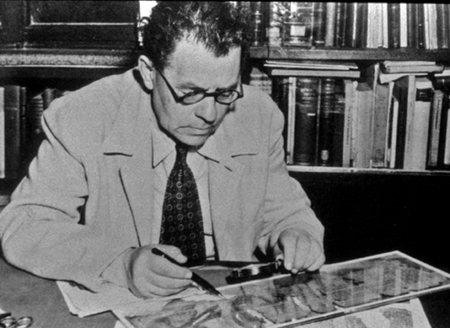 |
|
Courtesy of the
Israel Antiquities Authority |
|
Professor Eleazar Sukenik studying
one of the Dead Sea Scrolls |
| |
At this time, the
newly-formed UN was concluding its debate on the
future of Palestine and it was clear that war was
imminent. The UN vote about whether to
partition Palestine was to have been taken on
November 28th. When it was postponed for a
day, Professor Sukenik decided this was positively
his last chance to go with his Armenian friend to
the Bethlehem dealer holding the scrolls.
In a tense threatening atmosphere the next morning,
the two men made the journey by bus to Bethlehem.
In a musty attic not far from the Church of the
Nativity, they sipped cardamom-flavored Turkish
coffee and chit-chatted with the dealer in the
polite, round-about Oriental way, while the fateful
moments before the UN vote ticked away.
Finally, Professor Sukenik was shown two scrolls in
the jars in which they had been discovered.
When he began reading the Hebrew, Sukenik noted that
the language was in a style similar to the Psalms,
but the text was unknown to him. He brought
the scrolls home to Jerusalem to study and several
days later bought them. One was a collection
of psalm-styled poems, later named the Thanksgiving
Scroll and the other was an apocalyptic description
of a war in the end of days between the sons of
light and the sons of darkness. The price of
the scrolls was $324.00. Later Sukenik raised
additional funds and bought a partial text of Isaiah
(called Isaiah Manuscript 2) as well as two jars. |
| |
|
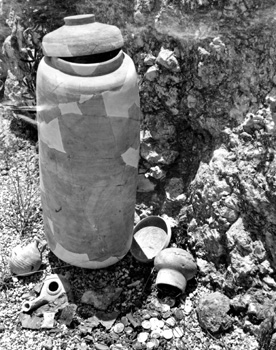 |
In the meantime,
Sukenik learned that the previous summer when he was
on sabbatical, the Syrian Orthodox Metropolitan had
asked Hebrew University scholars for their opinion
on the age and contents of four old scrolls.
The “experts” had examined the scrolls and declared
them to be “not particularly significant.”
When word reached the Metropolitan that Sukenik, a
Jew, had risked his life to travel to Bethlehem to
buy leather manuscripts, perhaps similar to the ones
in his possession, he decided to seek a second
opinion himself. He contacted the American
School of Oriental Research in Jerusalem. A
student named John C. Trever photographed the
scrolls and sent a copy on to headquarters in the
U.S. America’s top archeologist, William F.
Albright, immediately wired back,
|
|
Courtesy of the
Israel Antiquities Authority |
“Congratulations.
You have in your |
|
For 2,000 years, the scrolls were |
possession, the most
important manuscript |
|
preserved in earthenware jars |
find of the 20th
century.” |
The Metropolitan’s scrolls were taken out of Israel
to the U.S. and offered for sale in 1949, but no
buyers stepped forward. At the same time,
permission had been given to scholars at the
American School of Oriental Research to publish
facsimiles of the scrolls. Since the texts
were available to scholars for study, no one felt a
pressing need for the original manuscripts.
Professor Sukenik, who had dreamed of buying the
four scrolls for Israel, died in 1953. A year later,
his son, archeologist Yigael Yadin, while on a
lecture tour in the U.S., learned of the
difficulties the Metropolitan was having in finding
a buyer. He decided to purchase the four
scrolls for Israel, but the task demanded delicacy,
for the Jordanian government had already denounced
the Metropolitan as a traitor for taking the scrolls
out of the country. Yadin would have to buy
them anonymously.
|
| By coincidence, a
few days after Yadin had determined to search out
the scrolls, a small notice in the Wall Street
Journal offered the four Dead Sea scrolls for sale.
With a banker serving as intermediary, a sale price
of $250,000 was agreed upon. (Remember the original
purchase price was $97.20!) Today scholars
consider this one of the greatest antiquity bargains
ever struck. A single fragment from the Dead Sea
caves – not to mention complete scrolls – is
insured for hundreds of thousands of dollars. |
| |
|
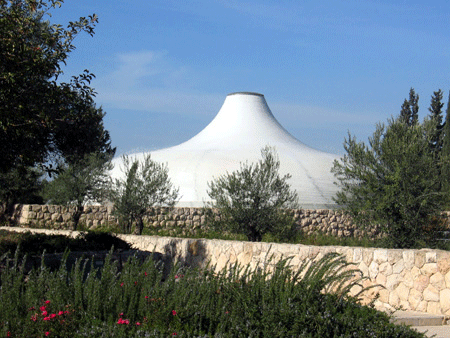 |
|
Photo: Gila
Yudkin |
|
The Shrine of the Book, built
in Jerusalem to house the scrolls,
was designed to resemble the lid of one of the
earthenware jars |
| |
The scrolls can be divided into four categories: a)
biblical manuscripts (the Isaiah Manuscript 1 and
Isaiah Manuscript 2); b) biblical manuscripts with
commentary (the Habakkuk commentary); c) apocryphal
manuscripts or an alternate biblical text (the
Genesis Apocrypha) and d) extra-biblical literature
(Thanksgiving Hymns, Sons of Light and the Sons of
Darkness, and the Manual of Discipline).
By far, the most important is the complete
manuscript of Isaiah, with all 66 chapters. As
recorded in Luke 4, Jesus unrolled the scroll of
Isaiah in his hometown synagogue and read from the
61st chapter of Isaiah, “The Spirit of the Lord is
upon me because He has anointed me to bring good
news to the poor.” Jesus’ interpretation of
the Scripture first astonished and then angered his
neighbors, so much so, that they conspired to push
him off the precipice of the closely-knit
conservative Galilean village. |
| |
|
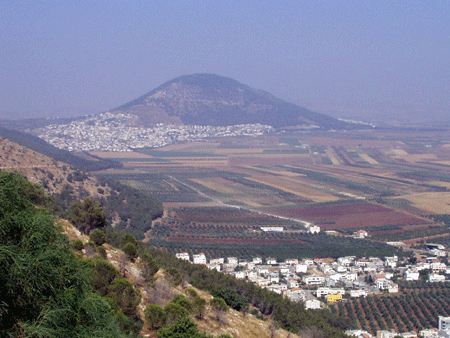 |
|
Photo: Gila
Yudkin |
|
View from the Nazareth precipice |
| |
| During our
pilgrimage around the Holy Land, we visit the
Nazareth precipice and read Luke 4 as we look way
down to the Jezreel Valley. The synagogue has not
survived the ravages of 2,000 years, but a scroll of
Isaiah has, because it was hidden in a cave in the
dry cliffs towering over the Dead Sea, some 100
miles south of Nazareth. |
| |
| |
| If there
were a best-seller booklist in the time of
Jesus, the Book of Isaiah would undoubtedly
top the charts. In addition to the two
Isaiah scrolls, another twenty-odd partial
copies of Isaiah plus six commentaries were
found hidden in the Judean wilderness caves.
Luckily, the Judean birds, that loved to
stuff their nests with biblical manuscripts,
overlooked the Isaiah hidden in Cave Number
1, so we do have a copy intact with all 66
chapters. That copy is dated to the
first century B.C. and is referred to as
Isaiah Manuscript 1. It is among the
most valuable manuscripts in the world. |
| |
|
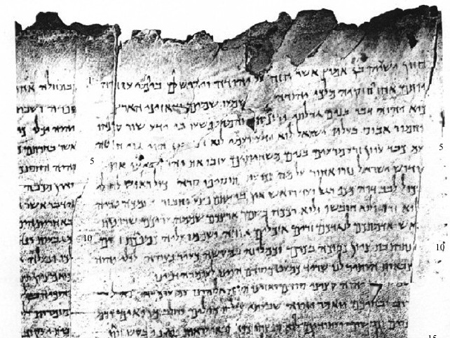 |
|
Photocopy
of a photo of Isaiah Manuscript 1 |
|
First fifteen lines of the
Isaiah scroll found by Beduin shepherds in
1947 |
| |
This
manuscript is made of seventeen leather
sheets, sewn together with linen thread.
Its fifty-four columns are ruled
horizontally with the writing dangling below
the lines. According to Yigael Yadin
who wrote Message of the Scrolls, the
scribe of this scroll made many minor
mistakes while copying it, most of which he
corrected himself.
Another scholar compared Isaiah 53, the
chapter about the “suffering servant,” in
the 2,000-year-old text of the Isaiah
Manuscript 1 with the Masoretic
(traditional) text and found a difference in
only seventeen letters. Ten are
differences in spelling like the American
‘color’ and the British ‘colour’. Four
are very minor grammatical changes, like
adding “and”. The remaining three letters
are the Hebrew word for “light” in verse 11
which was obviously added by a later scribe.
None of these variations change the meaning
of the text.
In the early 1990’s I heard from Brigham
Young University groups that a number of BYU
professors had partnered with Dead Sea
Scroll scholars to research the DNA of the
scrolls. And that they had concluded,
in addition to goat, calf and sheep leather,
some scrolls were written on ibex hide.
Nubian ibex (yaelim in Hebrew) are
native to the cliffs above the Dead Sea.
During our walk through the Ein Gedi oasis
18 miles south of Qumran, we mingle with
ibex who come to nibble on acacia leaves. |
| |
|
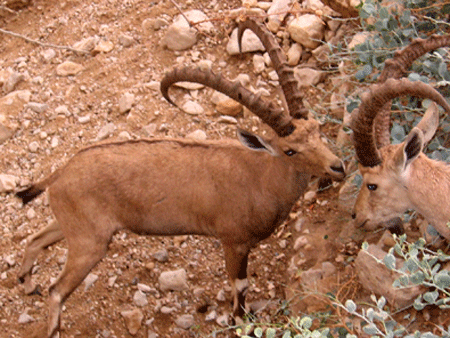 |
|
Photo:
Gila Yudkin |
|
Nubian ibex at Ein Gedi |
| |
It’s
estimated that the Isaiah scroll is composed
of the hides of nine animals. Tanning
the hides and preparing them for writing was
a complex and smelly process. Remember: In
Acts 10, Peter went up on the rooftop,
probably to catch the Mediterranean breeze
and escape the stench of dead animal hides
in the house, while he was staying at the
home of Simon the Tanner. Tanning was
performed by guild craftsmen who closely
guarded their “trade secrets.”
First, the fresh animal skin was washed and
then soaked in water, causing the hide to
swell. Next, the hair was scraped off
with a large, curved knife and the skin was
stretched on wooden frames and shaved to
make it as thin as possible, yet thick
enough to withstand heavy use. The
stretched skin was finally soaked in a
solution of salt, barley, flour, gall nuts
and lime water for several days and then it
was rinsed and dried flat.
Most of the Dead Sea Scrolls were written
with carbon soot ink from olive-oil lamps.
Honey, oil, vinegar and water were added to
thin the ink to the proper consistency.
Sometimes gall nuts were added to make it
more resilient. In the 1950s, at
Qumran, the settlement between the cliff
caves and the Dead Sea, Roland de Vaux,
excavator from the French School of
Archeology (Ecole Biblique) found two
ceramic inkwells and one made of bronze.
A later excavator in the 1960s found a
fourth inkwell there. |
| |
|
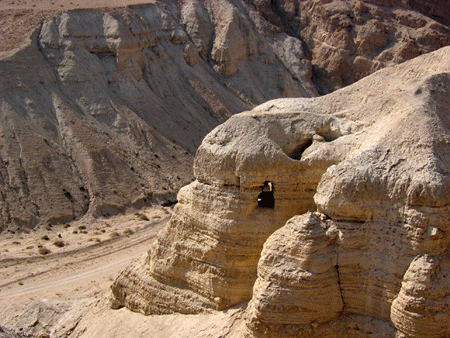 |
|
Photo:
Gila Yudkin |
|
Cave #4 at Qumran,
excavated by Roland de Vaux in the 1950s
|
| |
|
Tufts
University archeologist Jodi Magnes notes
the importance of finding four
inkwells in one location when she says, “I
have worked for many years on pottery
reading at various archeological sites, and
I have never yet found an inkwell in any of
the zillions of baskets of pottery that I
have sorted.” Other archeologists
concur. Nowhere else in the country
has anyone ever found more than one inkwell
at the same location. The four inkwells from
the “Scriptorium” at Qumran suggest that the
scribes headquartered here copied the
scrolls found in the caves nearby.
The existence of the 2,000-year-old
Isaiah scroll is a
tribute to the religious devotion of the
community that produced it and to the
prodigious skill of the scribes who copied
it. Although separated by more than
1,000 years from the later Masoretic
(traditional) text, Isaiah Manuscript #1 is
nearly identical to it, boosting our
confidence in the care with which biblical
texts were transmitted from one generation
to the next. Today we can open our
Bibles with assurance that we are reading
the same holy text as Jesus did, nearly
2,000 years ago. |
| |
Postscript
After writing this article, I contacted Kando’s son,
William, whom I’ve known for many years, and
asked if I could photograph the jar for my
website.
William immediately invited me for coffee
and I jumped at the chance to hear his
story
of the discovery of the jar. When it
was found by the Beduin shepherds in the
1950’s, the Temple Scroll was rolled inside.
(Exhibited at the Shine of the Book, the
Temple Scroll describes an imaginary ideal
temple to be established by the Essenes
in
Jerusalem.)
|
|
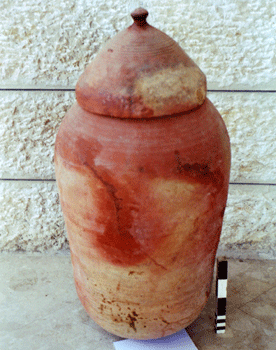 |
“The Beduin,” says William Kando, “were more
clever than the scholars. They
knew
how to identify caves where people would
have lived and found the scrolls easily.” When the Beduin brought the jar and the
scroll to his father, Khalil Kando, he
bought them without hesitation. He
offered the Temple Scroll to the Jordanian
Department of Antiquities and to the
Rockefeller Museum in East Jerusalem, but
neither could come up with the money.
In 1967 the government of Israel expropriated
the scroll as a part of its conquest of East
Jerusalem and Bethlehem. The jar,
however, remained
in the possession of the
Kando family and has been on display in
their shop since 1963. “Since I was 21 years old,” says William
Kando, “I stood by my father and learned pottery and
glass. I observed his dealings first
hand. If my father wasn’t |
|
Courtesy of
William Kando |
100% sure
that a piece was genuine, he |
|
The original jar at Kando's
shop |
would show it
to scholar friends and get |
|
|
their expert
opinion. |
“I was twice with my father at Moshe Dayan’s home,” continues William. “He
was solely interested in pottery and
scarabs. After the Six-Day-War, pieces
came from Lebanon and Jordan, because the
antiquities market in Israel was thriving.
The best pieces my father offered first to
the Israel Museum. They would say
whether they were interested and my father
would wait until they found someone to
donate the money to purchase the item for
display.”
“The Prime Minister’s Office also bought
antiquities from us to be given as gifts,”
recalls William. Prominent in the shop
is a photo of Prime Minister Yitzhak Rabin
at
the Vatican, where he’s presenting a pottery
jug from the time of Jesus to Pope John Paul
II. The photo is dedicated to the
Kando Brothers (Kando, the old man had died
in 1993) with best wishes from Yitzhak
Rabin.
William Kando can generally be found at his
new shop opposite Rachel’s Tomb in
Bethlehem. By special appointment, he
opens the old antiquities shop near the
Garden Tomb. |
| |
|
Copyright 2006,
2010
Gila Yudkin. Permission needed for any reuse. |
| |
|
For more about the Dead Sea Scrolls, see
"The Dead Sea Scrolls from A
to Z." |
| |
| More Holy Land
explorers |
|
|
|
|
|
GILA
YUDKIN
•
TCHERNIKOVSKI
64A
•
JERUSALEM
•
ISRAEL
gila@itsgila.com
HOME
•
BOOK
GILA •
TIPS
FOR TOURS •
ABOUT GILA
|
|

